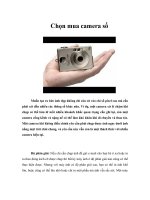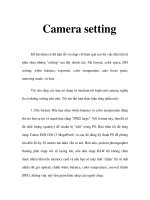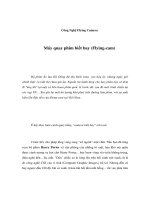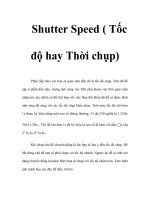E02 Camera Basics Shutter Speed
Bạn đang xem bản rút gọn của tài liệu. Xem và tải ngay bản đầy đủ của tài liệu tại đây (1.35 MB, 10 trang )
Camera Basics : Shutter Speed
When taking photographs, you want to have a good grasp of shutter speed
and its effects on your photographs. What kind of effects can you create with
a faster or slower shutter speed? Let us examine the effects of different
shutter speeds with the help of the following examples .
Shutter speed helps you “control” the movement of the subject in your
photos
Points-to-note
- A faster shutter speed freezes the subject in motion.
- A slower shutter speed creates a motion blur effect from the movement of
the subject.
- You can adjust the amount of light by opening/closing the shutter.
The shutter speed (also: exposure time) is the length of time when the
shutter is open and light can enter the image sensor inside the camera. The
shutter speed is indicated as 1 sec, 1/2 sec, 1/4 sec... 1/125 sec to 1/250
sec, etc.
A faster shutter speed reduces the length of time where light can enter,
whereas a slower shutter speed increases this length of time. Therefore, the
slower the shutter speed, the greater the amount of light that can enter the
camera.
hutter speed not only allows you to modify the amount of light, it can also
change the way the movement of a subject is captured. At a faster shutter
speed, you can completely freeze the action of a moving subject.
Conversely, when you use a slower shutter speed , you can blur the subject
in the direction of motion, and therefore capture the motion of subjects such
as flowing water. In other words, the shutter speed allows you to control how
the movement of a photographic subject is depicted.
Use shutter speed settings to change how the movement of
photographic subjects is captured
EOS 5D Mark III/ EF24-105mm f/4L IS USM/ FL: 105mm/ Shutter -priority AE
(f/14, 1/10 giây, EV+1,3)/ ISO 100
1/10 giây
EOS 5D Mark III/ EF24-105mm f/4L IS USM/ FL: 105mm/ Shutter-priority AE
(f/8, 1/160 giây, EV+1,3)/ ISO 100
1/160 giây
EOS 5D Mark III/ EF24-105mm f/4L IS USM/ FL: 105mm/ Shutter -priority AE
(f/4, 1/2500 giây, EV+1,3)/ ISO 400
1/2500 giây
Depending on the movement of the subject, adjusting the shutter sp eed
allows you to control how the movement of a subject is captured – whether
you use a faster shutter speed to freeze the action of a subject, or choose to
capture its movement by using a slower shutter speed.
Concept 1: Motion blur and camera shake
There are two types of blur, ‘motion blur’ and ‘camera shake’, which
originate from different sources. Motion blur occurs when the movement of
the subject is faster than the shutter speed. The background is not moving,
and so only the subject is blurred. Camera shake occurs when the hand that
is holding the camera shakes as the shutter is released, causing the entire
image to be blurred. In both cases, blur can be prevented by increasing the
shutter speed.
EOS 5D Mark III/ EF24-105mm f/4L IS USM/ FL: 105mm/ Aperture-priority
AE (f/22, 1/2 giây, EV+0,7)/ ISO 100
Motion blur: Only the subject in the centre is blurred
EOS 5D Mark III/ EF24-105mm f/4L IS USM/ FL: 105mm/ Aperture AE (f/11,
1/6 giây, EV+1,0)/ ISO 100
Camera shake: The entire photograph is blurred.
Concept 2: The relationship between shutter speed and number of
stops
When we increase the shutter speed from 1/30 sec to 1/60 sec, for example,
this halves the length of time when the shutter is open and we refer to it as
“making the shutter speed 1 stop faster”. On the other hand, when we
decrease the shutter speed from 1/60 sec to 1/30 sec, we double the length
of time when the shutter is open and therefore “slow the shutter speed by 1
stop”.
Generally, the shutter speed of a DSLR camera can be adjusted in intervals
of 1/2 and 1/3 stops in addition to 1 stop. For example, using 1/2 stops, 1
stop can be divided into two intervals for shutter speeds of 1/30 sec, 1/45
sec and 1/60 sec, with an additional speed in between. The amount of light
entering the camera can be more finely adjusted by using smaller intervals
like these half-stops (1/2 stops).
Useful fact: The shutter speed range differs between cameras
Each camera model has predetermined upper and lower shutter speed limits,
and you can freely adjust the shutter speed within that range of values. W ith
a camera that has a high-speed shutter with an upper limit as fast as 1/8000
second, not only will you be able to freeze the action of rapidly moving
subjects in your photographs, you will also be able to widen the aperture
(i.e. lower the f-number) even in bright settings, and this can be used to
your advantage when taking shots with bokeh. In addition, in auto exposure,
many cameras have a lower shutter speed limit as slow as 30 second s. If
you want to slow the shutter speed even further, use the “BULB” function.
How to measure shutter speed
Shutter speed is measured in seconds, or in most cases measured in fractions of a second,
expressed as a fraction - the larger the denominator, the faster the speed (i.e. 1/1000s is much
faster). compared to 1/30s).
Today's DSLR or Mirrorless cameras can handle shutter speeds up to 1/4000 sec, even some
high end cameras can handle 1/8000 sec or faster.
The camera can handle shutter speeds up to 1/4000 sec
When figuring out what shutter speed to use for a particular photo, you need to evaluate if
anything in the picture you're going to take can move and you want to capture those movements
like how. If there's movement in your scene, you can select or freeze the movement to have it
captured as still in the photo; or let moving subjects be intentionally blurred to give a sense of
motion.
Freeze motion or intentionally let moving objects become blurred
The longest shutter speed is usually set to 1/30 of a second with most cameras. You can of
course adjust the shutter speed longer if needed. If you use a slow shutter speed (slower than
1/60s), you will need to use a tripod or some kind of camera with good image stabilization.









